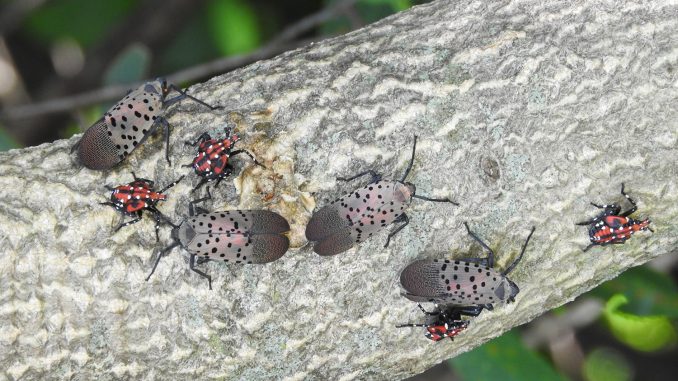
The New York State Department of Agriculture and Markets is urging residents to remain vigilant in identifying the spotted lanternfly, an invasive plant hopper from Asia that continues to pose a threat to East End vineyards.
The insect can feed on grapes and many other types of leaves, stems and trunks, using its specialized mouth parts to pierce the plant. The spotted lanternfly was first discovered in the United States in 2014 in southeastern Pennsylvania.
“We’ve been concerned about spotted lanternfly from day one when Pennsylvania discovered it,” said Chris Logue, director for plant industry at Ag and Markets. “We’re always concerned about invasive species. This one is particularly challenging because it does move in many different ways.”
The spotted lanternfly, which undergoes five life stages before reaching adulthood, has not yet been confirmed on the East End, but it was seen near MacArthur Airport in Ronkonkoma about a year ago. Mr. Logue, speaking at a virtual press conference Monday afternoon, said there have been no sightings confirmed closer to the East End since then. It was first confirmed in New York in 2020 in Staten Island and has since been established in all different regions of the state.
The wine and grape industry remains the key concern for the kind of damage the spotted lanternfly can inflict. In November, Cornell Cooperative Extension of Suffolk County issued an alert for the spotted lanternfly after it was confirmed in the county.
Mr. Logue said hops, apples, any other type of fruit crop and red and silver maple trees are also at risk. The damage seen in vineyards in other parts of the country has occurred mostly in newly planted crops, which are more susceptible to “that piercing, sucking damage from the lanternflies’ mouth parts,” Mr. Logue said.
He added that a chief concern from the Department of Agriculture’s standpoint is the economic impact invasive species can have, particularly for New York’s estimated $300 million grape and wine industry.
In large populations, the spotted lanternfly can also make it uncomfortable for people to be outside in their yards, he said. There’s no threat, otherwise, to humans or animals and the insects do not bite people.
The Department of Agriculture has been working with several different agencies — including the state departments of environmental conservation; parks, recreation and historic preservation; and transportation — to monitor for spotted lanternfly.
Anyone who believes they may have seen a spotted lanternfly is asked to document it using the state’s online reporting tool, which can be found here. Identifying the insect on the East End would be particularly important so the population does not grow enough to become problematic to a vineyard, for example.
“If you’re upstate or [on] Long Island, we really do urge you to report this to us so that we can follow up on it,” Mr. Logue said.
The adult spotted lanternfly can be colorful when its wings are displayed. They have red hind wings with black spots, a black head and yellow abdomen with black bands. They are easiest to see at dusk or night. They can excrete honeydew while feeding, which “falls down on the plant material that it’s feeding upon,” Mr. Logue said.
He added that it’s currently the adult flight season, so people traveling to wine-growing regions like the North Fork should inspect their vehicles to be sure the insects are not “hitchhiking with you,” Mr. Logue said.
“That’s really important for folks who are living in infested areas,” he said. “We want to minimize the spread as best we can.”
New York City residents who may see a spotted lanternfly can simply try to kill it. Mr. Logue said the department is less concerned about specific reports in the city.
In the fall, the egg laying begins so people should be aware of any potential egg masses that could develop on an RV or boat trailer, for example, or on any types of goods that may be shipped. Each egg mass contains 30 to 50 eggs covered in a waxy brown substance.
For a vineyard to sustain noticeable damage would require a large population of spotted lanternfly, Mr. Logue said.
“I think for vineyard owners, being vigilant and being on top of treatments is going to be really, really important,” he said.
The spotted lanternfly can be controlled with insecticides and Mr. Logue encouraged people to check with Cornell Cooperative Extension for specific recommendations, which can vary by region.
While the spotted lanternfly is known to feed on over 70 different plant species, there’s currently no evidence it has gone after hemp or marijuana crops.
Faruque Zaman, an entomologist at the cooperative extension, told The Suffolk Times last November that extension has a plan for on-farm monitoring of the spotted lanternfly in vineyards and fruit orchards, including using circle traps around tree trunks to intercept young insects.
To find more information online, visit https://agriculture.ny.gov/spottedlanternfly.

